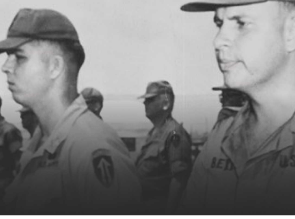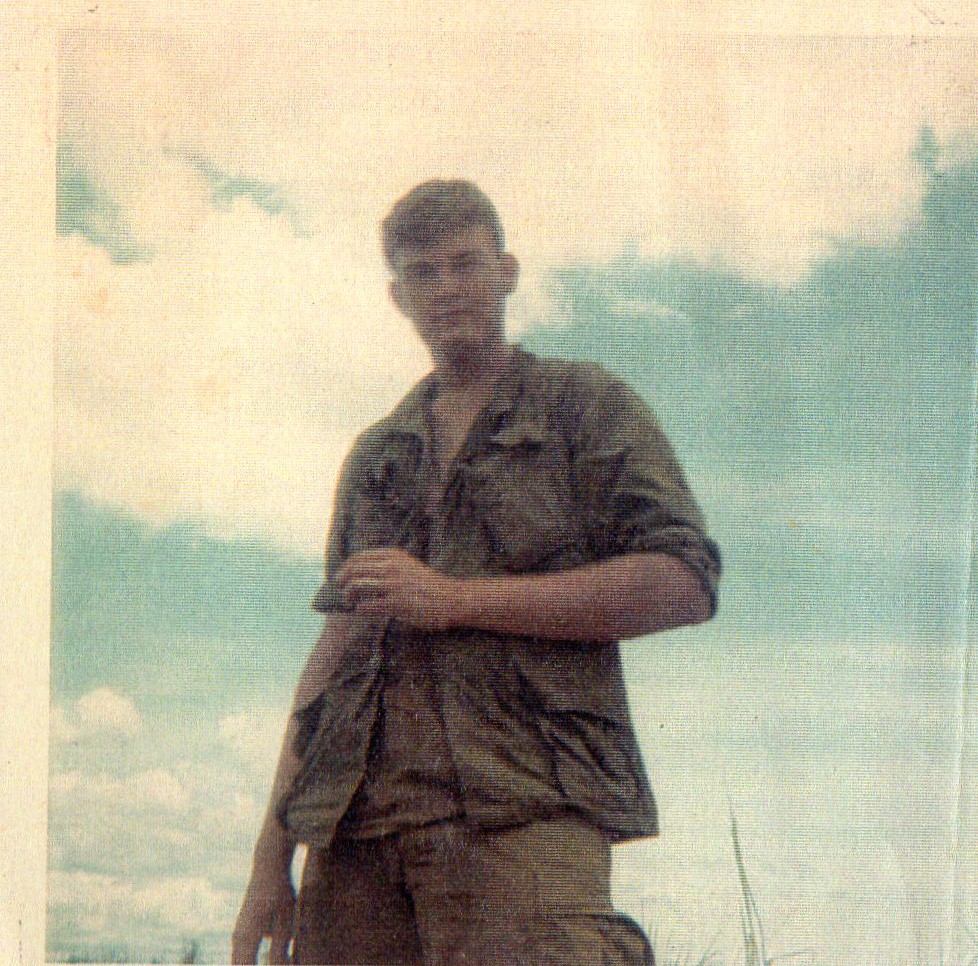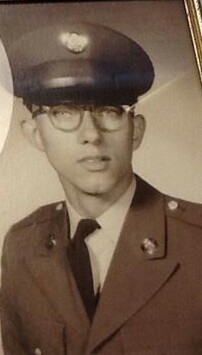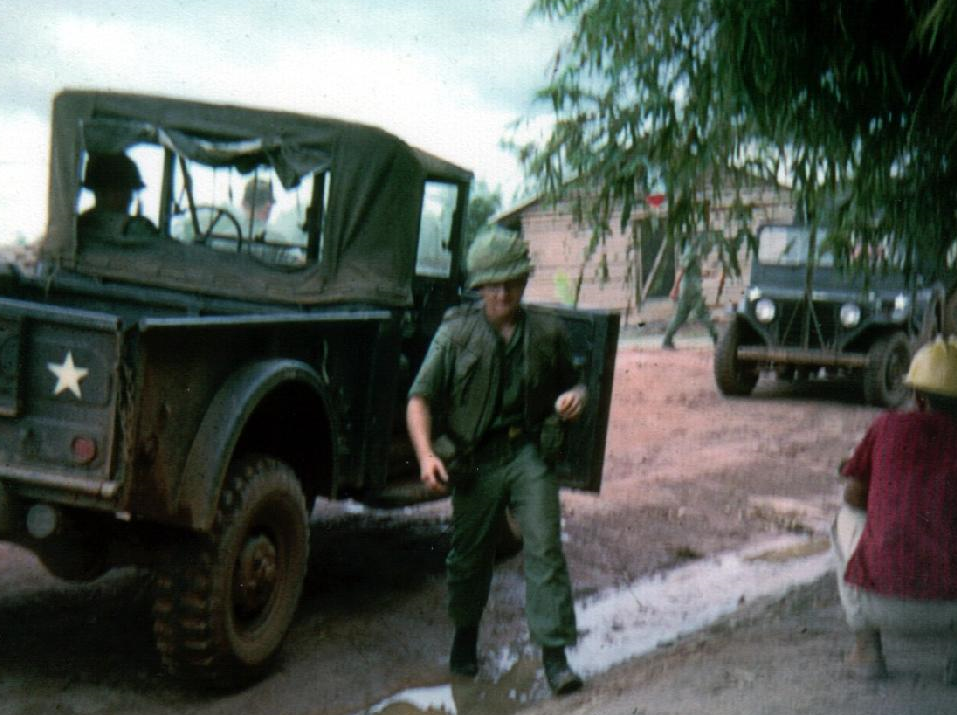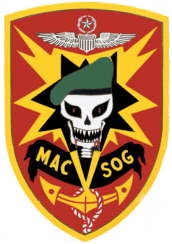The Ambush of Team Grasshopper
A Ranger “Heavy Unit” comprised of eleven soldiers are ambushed by a large NVA unit and fight for their lives during the next ten hours. Read what happened on that fateful mission.
By Gary Linderer – originally posted on VietnamGear.com Nov. 2005 (I added the photos for this story / John P.)
Forwarded to me by my friend John M. DeCillo. “This story includes a friend and former co-worker of mine from my Railroad days. His name is Paul ” Blinky” Morgucz. Paul Passed away in the late ’80s as I remember. He was stricken with several AGENT ORANGE related diseases. R.I.P.”
*****
In the spring of 1970 L Company, 75th Infantry (Ranger), 101st Airborne Division found itself running more and more “heavy” teams deep into enemy territory. This was not due so much to the nature of the missions being assigned as it was to the areas where they were being conducted.
During the past two months, an unusually large number of “hot” LZs and heavy contacts within the first few hours of insertion had created a serious need to strengthen the ability of the long-range reconnaissance teams in the filed to defend themselves. Hopefully, the “heavy” recon team was the answer.
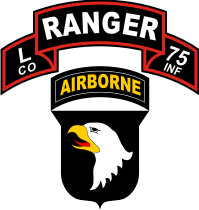
At the same time, there was a strong effort to develop new strategies designed to deceive the enemy into believing that they were dealing with something other than a conventional long-range reconnaissance team.
On 8 April 1970, Team Grasshopper provided a perfect example of the increasing enemy resistance to long-range patrol operations into their own sacred sanctuaries when an eleven-man “heavy” team led by Sergeant Bernie Zentner was assigned a reconnaissance patrol into a, particularly bad area in northern I Corps. Other patrols had gone into the same area during the previous two months and had been shot out within hours of inserting. This time the Rangers inserted in four slicks, the last two being empty. Hopefully, anyone watching would believe that this was a bigger operation than a long-range recon patrol. The LZ was located on the finger of a major ridgeline, with a freeway-like trail running the entire length of the finger and a number of secondary trails branching off the main trail. Unlike most well-hidden enemy trail networks, this one had been relatively easy to spot during the overflight the day before.
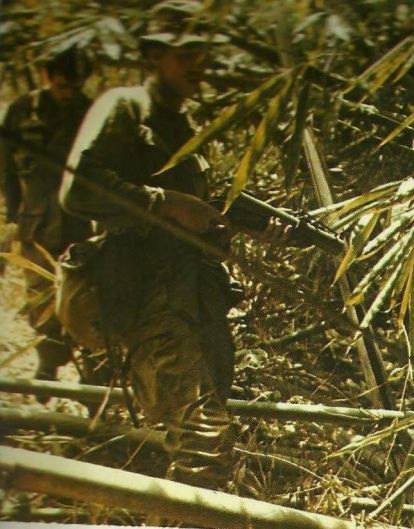
Sergeant Steijen had been assigned to walk point for the patrol with a Kit Carson scout named Ut pulling his slack. Steijen, Ut, SP4 Paul “Blinky” Morgucz and Sergeants Frank Johnson and Bruce Bowland were on the first slick into the LZ. They hit the ground running and immediately spotted a large number of NVA to their east sprinting downhill, moving away from the LZ.
A LOH scout helicopter covering the insertion immediately spotted two more NVA on the trail above the LZ and radioed the recon team to report it. The Rangers waited on the LZ for a few minutes trying to determine the enemy’s intentions. When nothing happened Sergeant Zentner decided to send a scouting party down the trail to the east in the same direction that the larger group of NVA had disappeared.
Rangers Steijen and Johnson, along with the Kit Carson scout, then patrolled about 100 meters away from the rest of the team before Ut observed several NVA on the move just ahead of them. The Kit Carson scout backed up slowly and reported to the two Rangers that he suspected a very large enemy base camp was located nearby.
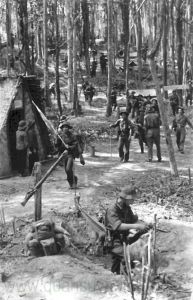
The three men scampered back uphill to rejoin the recon team and to report the enemy sighting before discussing their next move. It was now obvious that they had been spotted coming into the LZ and were now compromised. They had lost the element of surprise, but if they moved quickly they could still salvage something out of the mission. Zentner decided that they would have to outfox the enemy. After kicking around a number of options, he decided to move the patrol back down the hill to hunt the NVA. He knew that the AO was hot, and the enemy would soon be out in force looking for them, so Zentner and his Rangers opted to beat them to the punch. They would go after the NVA and a body count. It would be the last thing the enemy would suspect.
Sergeant Zentner moved the team about 500 meters from the LZ and then pulled his men into some dense cover nearby and waited. It was nearly 16.30 hours and they had already been on the ground for three hours. Zentner radioed quietly for the slicks to return to the LZ and fake an extraction, hoping to dupe the NVA into believing the Americans had departed.
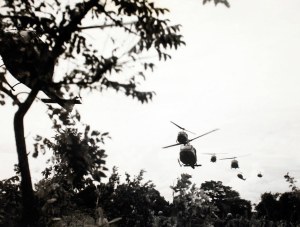
As the first slick was climbing for altitude and the second slick was just pulling away from the LZ, all hell broke loose. An NVA .51 caliber heavy machine gun opened up on the extraction aircraft from a hidden position less than 75 meters below the team. As the large caliber weapon pounded the helicopters, the Rangers could hear the enemy soldiers laughing as they moved up the hill toward the camouflaged Rangers, not realizing that they were even there. Specialist Mike “Gringo” Blinston spotted them first, opening up and killing the pointman before the NVA soldier could react. The remaining NVA responded immediately by rushing the Rangers’ perimeter.
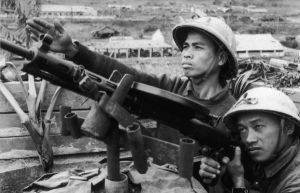
Rangers Rob McSorely, Bernie Zentner, and Mike Blinston were in the direct line of the initial enemy assault. McSorely, reacting instantly, grabbed the M-60 from Zentner and opened up on the massed enemy soldiers, killing two outright and wounding several others, and throwing the enemy into general confusion. In the heat of battle, McSorely turned and yelled over his shoulder to his buddy, Frank Johnson, “Wow, I feel just like John Wayne!”
With their frontal assault stopped cold, the NVA regrouped then attempted to flank the Rangers. But the Americans were putting out too much firepower with McSorely dealing death with the M-60, while Johnson lobbed multiple M-79 rounds to airburst in the trees above the enemy. The NVA were forced to withdraw, giving up on the idea of flanking the team.
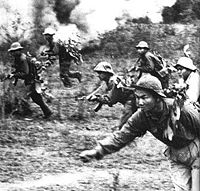
During the first twenty minutes of the enemy’s initial assault, the patrol experienced some difficulty setting up commo with the C&C aircraft circling off at a distance. When they finally managed to establish radio contact they requested immediate gunship support.
A few minutes later the embattled Rangers received word that they had a Cobra circling overhead on station. McSorely, always ready with a bit of humor, commented on what a fuzzy feeling a friendly Cobra provided. Attempting to relay commo for the Ranger patrol, the Cobra pilot radioed in the team’s contact, then dropped down to place suppressive fire on the enemy.
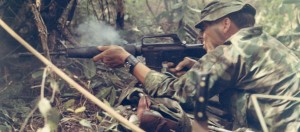
Suddenly, an RPG round sailed in out of nowhere and exploded ten meters in front of the Ranger’s small defensive perimeter, showing the patrol with shrapnel. But fortunately, only Steijen was hit, catching a piece of metal in his left forearm.
Minutes later Mike Blinston took an AK-47 round through his left bicep. McSorely spotted the NVA who had shot Blinston and quickly killed him before he could duck back out of sight.
The vicious firefight lasted for the better part of an hour with small arms and grenades being the primary unit of exchange. Finally, Zentner decided it was time to break contact and attempt to get back to the patrol’s original LZ. With darkness less than two hours away, Zentner knew it was time for the Rangers to grab their winnings and get out of town.
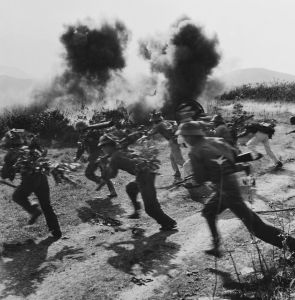
While the Rangers round-up their gear and pulled back towards the clearing, Johnson remained behind to set up a “Claymore/Willy Pete surprise package” to leave behind for their pursuers. The daring young Ranger waited off to the side of the trail hidden in heavy cover until nearly a dozen NVA were within his immediate kill zone. Then he squeezed the claymore’s detonator and took down the entire group with a deadly blast of steel pellets and liquid fire.
Behind Johnson, the rest of the patrol had already moved nearly 100 meters closer to the LZ, when McSorely, out on point, ran headlong into a second enemy force maneuvering down on the Rangers from the high ground. The Ranger pointman opened up, killing three NVA before his CAR-15 jammed. Before he could clear the malfunction, the remaining NVA in the party opened up spraying him across the chest.
McSorely had been nearly ten meters ahead of his slackman and the rest of the patrol when he encountered the NVA column. Now the rugged young Ranger lay severely wounded ten meters out in the open with the NVA still firing up the team. Sergeant Bill McCabe was also hit hard in the elbow by an NVA bullet, shattering it and knocking him out of the fight. Zentner, coming up quickly in reaction to the enemy small arms fire to their front, opened up with his M-60 dropping two more NVA in their tracks.
By this time Johnson had caught up to Ut, Morgucz, and Sergeant Gary Sands who were waiting for him just up the trail from his successful one-man ambush. The three Rangers and their Kit Carson scout soon reached the rest of the patrol minutes after McSorely and McCabe had been hit. Getting word of their injuries, Honshon and Morgucz immediately headed to the front of the patrol intending to go out after McSorely.
Rob McSorely had been a good friend to Johnson and a mentor and a hootch mate to Morgucz. Neither Ranger was about to leave him out in open with NVA bullets flying overhead. But before they could move ten feet, Sergeant Sands ordered them to stop and go back, telling both Rangers to remain in the rear to guard the team’s back trail. Sands shouted that he would go out and retrieve McSorely, and with that, he headed for the front of the patrol.
Minutes later, Sands reached the front of the patrol and low crawled ten meters across the fire-swept open area to reach McSorely who, miraculously, was still alive. With enemy bullets buzzing past like enraged hornets, the Ranger NCO crawled back to the perimeter dragging the wounded and screaming McSorely behind him. But in spite of Sands’ heroic effort, Ranger Rob McSorely died 15 minutes later.
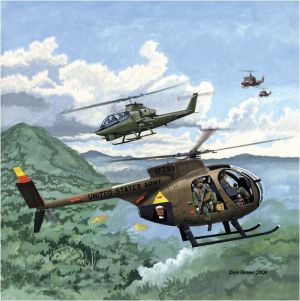
Painting by Don Greer
Above the Rangers’ perimeter, the Cobra gunships began working their rockets and mini-guns in closer than working back out again, eventually silencing the heavy enemy fire coming from below the Rangers’ position. A short while later, the enemy fire coming from above them slackened then grew quiet. Zentner took heart and yelled encouragement to the rest of his team. Arrangements were being made to extract them, and everyone had to hold on.
Finally, it began to grow dark, and with the darkness, the danger of being overrun by the enemy has now magnified a hundredfold. But fortunately for the Rangers, a C-130 “Spooky” flare ship arrived on the scene and drooped parachute flares over the trapped Rangers for the better part of an hour.
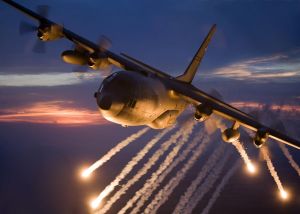
When the Spooky finished illuminating the area Johnson low crawled out about 20 feet downhill from their perimeter, set up another claymore, then returned to his position. It was a good move because 20 minutes later Johnson, Morgucz, Ut, and Sands who had just rejoined them heard the NVA moving up from below. Johnson waited until the enemy soldiers were directly in front of the claymore before squeezing the clacker. The explosion erupted right in their faces and devastated the enemy assault. With several more of the attacking force now lying dead or dying on the slope the NVA withdrew once again to lick their wounds.
During the remainder of the night, the enemy continued to maneuver around the trapped patrol, remaining just out of sight in the surrounding underbrush. They were obviously looking to exploit a weak spot in the Rangers perimeter. But the Americans kept them at bay with timely and accurate grenade tosses. Sands and Morgucz, both firm believers in the killing power of hand grenades, between them tossed out more than forty fragmentation grenades, killing and wounding a number of NVA who had moved within ten meters of the Ranger perimeter. Johnson, Bowland, and the Kit Carson scout killed several more with highly accurate small arms fire. The enemy must have been convinced that there were no weak spots in the Rangers’ perimeter.
During the fight that night the enemy succeeded in bringing up more .51 caliber machine guns and opened fire on the circling slicks and gunships from two nearly ridgelines. The Lima Company Rangers had indeed kicked the top off a Hornet’s nest, and the Hornets were stirred up and madder than hell. Surviving the next few hours were going to take a combination of skill, luck, and maybe a little Divine intervention.
Later that night, a medevac helicopter attempted to hover over the patrol’s perimeter to hoist out the team’s dead and wounded, but the enemy fire was too intense for the aircraft to remain on station for long. Before the aircraft departed the Peter pilot was killed, and the aircraft commander and crew chief were both wounded.
Just after midnight, a “Stinger” gunship arrived over the patrol. The pilot requested that the Rangers mark their positions with a strobe light. One of the new Rangers, SP4 Dave Hazelton, moved into the center of the perimeter and took up a position lying on the ground on his left side. Shaking in fear but fighting to stay in control, he extended his right arm in which he held a flashing strobe. He continued to do so through the remainder of the battle, lowering his arm only when there was no support aircraft on station.
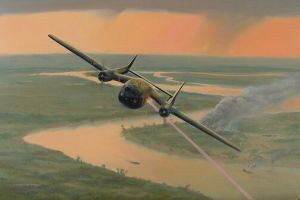
The Stinger aircraft went into a tight orbit over the trapped patrol firing its mini-guns in a tight arc around the Ranger’s perimeter. During one of the Stinger’s final gun runs in support of the team an errant burst of fire ripped through the middle of the patrol without hitting anyone. It was indeed a miracle!
Finally, at about 00.20 hours, and after the Stinger gunship had successfully suppressed much of the enemy small arms and anti-aircraft fire, a pair of Huey slicks made another attempt to get out the casualties. The first slick moved in over the LZ and hovered directly above the team. The crew chief quickly lowered a jungle penetrator, lifting out McSorely’s body and the badly wounded McCabe. When the first aircraft had departed the area the second Huey edged in over the LZ to replace its mate. The crew chief kicked out a pair of Maguire rigs, pulling out Steijen and Blinston, the last two wounded team members. The six surviving Rangers and their Kit Carson scout were still on their own on the ground battling for their lives.

At 02.05 hours, while a pair of Cobras worked over the surrounding area, another slick arrived on the scene and kicked out a ladder directly over the patrol’s smoke-filled perimeter. With red, white, and green tracers still crisscrossing through the night, the remaining seven men bobby trapped their rucks and those of the dead and wounded who had already been extracted, then turned and climbed the swaying ladder into the waiting Huey.
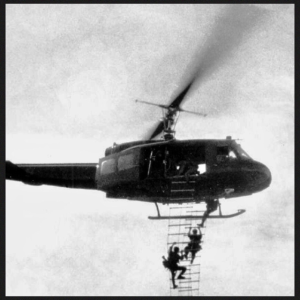
The survivors arrived back at the Lima Company compound at Camp Eagle at 03.15 hours. They had been in continuous heavy contact for over ten hours. Physically they were spent, and emotionally they were just beginning to experience the come down that always proceeded a battle. The entire company had turned out to welcome them back. They were escorted to the mess hall by their jubilant comrades where they were fed all the steak and eggs they could hold. It was a long-standing tradition for Lima Company Ranger returning from harm’s way.
The team had lost one Ranger KIA, and three more had been wounded. Four Cobra gunships and two Huey slicks had taken hits and sustained serious damage. The Stinger gunship had also been fired upon while supporting the trapped team. A medevac pilot was killed, while three other pilots and two crewmen were wounded. It was a tragic day for the U.S. Army, but he NVA had paid a much, much heavier price in manpower for the casualties and the damages they had caused.
A flight of U.S. Air Force fighter/bombers was ordered in that night to work over the battleground, and an infantry unit from the 101st Airborne Division was inserted the next day to search the area. The Rangers remembered to send word back that they had booby-trapped their gear so that none of the grunts would find themselves on the short arm end of a “hot” fragmentation grenade.
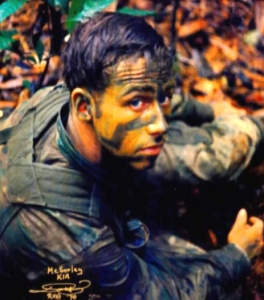
McSorely’s loss was a serious blow to the company. The affable Ranger NCO was a brother, a team-mate, and a good friend to all. His death was doubly tough on his fellow Rangers because Sergeant Rob McSorely was a Canadian citizen who, unlike the rest of Lima Company, did not have to serve in Vietnam.
The Ambush of Team Grasshopper – CherriesWriter – Vietnam War website
Thank you for taking the time to read this. Should you have a question or comment about this article, then scroll down to the comment section below to leave your response.






